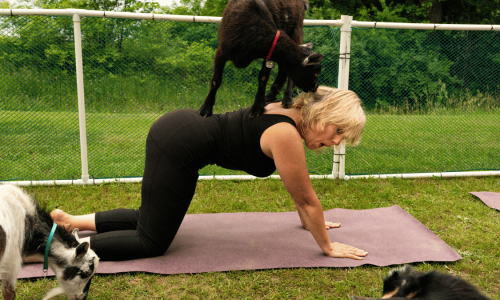House-training a dog is a task many pet owners face, especially when it comes to preventing indoor urination. Understanding why dogs pee inside and how to address it effectively is crucial for maintaining a clean and harmonious home environment.
This article aims to explore practical and current strategies to discourage your dog from peeing indoors. Whether dealing with a puppy’s learning curve or managing an older dog’s habits, we’ll explore a range of solutions that cater to different needs and situations. We aim to offer insightful and actionable advice, ensuring your living space remains comfortable and welcoming for you and your furry friend.
Related Post: 5 Reasons Why Goat Yoga Is Not Good for You
Table of Contents
ToggleWhy Do Dogs Pee in the House?
Dogs occasionally relieve themselves indoors, which can be frustrating for pet owners. Understanding the underlying reasons can help address the issue effectively.
Common causes include fear-based reactions, such as anxiety from loud noises or unfamiliar visitors. Older dogs with arthritis may struggle to reach the outdoors quickly, leading to accidents. Younger pups might resist going out in inclement weather, while new pets, furniture changes, or disruptions in routine can also cause confusion and contribute to indoor urination.
Additionally, health conditions like diabetes or kidney disease can impair a dog’s ability to control their bladder. Excitement, especially in younger dogs, can sometimes lead to accidents. Adult dogs might also experience lapses in housetraining due to changes in their living environment, such as moving or the introduction of new pets.
By recognizing these potential causes, pet owners can take appropriate steps to prevent and address indoor urination, ensuring a harmonious living environment for both dogs and humans.
How to Stop Your Dog from Peeing Inside: Effective Tips and Solutions
Commercial Deterrent Sprays
If you’re trying to stop your dog from peeing indoors, commercial deterrent sprays are a popular and effective option. These products are designed to discourage dogs from returning to and marking the same spots in your home.
Purpose and Function: These sprays work by neutralizing the odors that attract dogs back to specific spots or by emitting scents that dogs find unpleasant, though harmless to humans.
Popular Products: Top choices include Nature’s Miracle Spray and Rocco & Roxie Pet Stain & Odor Eliminator. Both are highly regarded for their ability to prevent dogs from repeatedly marking the same areas while also removing lingering odors.
Ingredients: Many of these sprays are made with eco-friendly and natural ingredients, ensuring they’re safe to use around both pets and people.
Individual Variability: Effectiveness can vary depending on your dog’s preferences. It may take some experimentation to find the right product that successfully discourages your dog from peeing indoors.
DIY Anti-Dog Pee Sprays
For a budget-friendly option, making your anti-dog pee spray can be a great solution.
Vinegar & Citrus Spray: Mix equal parts water and white vinegar with citrus peels. The strong scent of vinegar combined with citrus notes creates a powerful deterrent that’s safe for your dog and family.
Baking Soda Solution: Dissolve baking soda in water to create a mild, non-toxic spray that neutralizes urine odors without harsh chemicals.
Alternative Mixes: For tougher odor challenges, try hydrogen peroxide, mouthwash, or rubbing alcohol. These solutions can effectively cut through urine smells but should be used carefully to avoid damaging fabrics. Keep them out of reach of pets.
Additional Natural Remedies
Natural repellents offer a safe and eco-friendly way to prevent your dog from peeing indoors. Beyond vinegar and citrus, several other natural ingredients can help keep your home clean.
Mustard Oil: Apply a small amount of mustard oil in areas you want to deter your dog from visiting. Its strong aroma can be very effective.
Chili Powder: Sprinkle chili powder lightly around garden beds or specific indoor spots. Use it sparingly and ensure it won’t harm your dog.
Lemon Juice: Mix lemon juice with water to create a spray that leaves a fresh scent while deterring dogs.
Eucalyptus Oil: Dilute eucalyptus oil in water and spray it around your home. It acts as a natural repellent for dogs.
These natural solutions offer a variety of options, allowing you to find the best method for both you and your pet.
Preventing Future Accidents
- Preventing future accidents requires consistent training, creating a positive environment, and sometimes using deterrents.
- Establish a consistent bathroom routine for your dog, especially after meals and first thing in the morning.
- Use positive reinforcement to reward your dog for going outside.
- Keep a close eye on your dog, especially if they are prone to accidents, so you can catch and redirect them.
If accidents persist, consult a veterinarian or professional dog trainer. There may be underlying medical or behavioral issues that need addressing.
Conclusion
Helping your dog stop peeing inside isn’t just about finding the right spray or deterrent—it’s about understanding your dog and building a strong bond. Every dog is unique, so what works for one might not work for another. You might need to try a few different methods to find what works best for your pup.
Communication is key. Your dog wants to make you happy, but they might not always get what you’re asking for. Be consistent with your training, set a regular schedule for bathroom breaks, and reward them with praise and treats when they do well. And if there’s an accident, no worries—just clean it up calmly and keep moving forward.
Most importantly, don’t lose hope. It might take a bit of time, but with patience, love, and the right approach, you and your dog can get through this together. A clean, happy home is possible, and the journey will only strengthen your bond.
FAQs
Q: Can these natural repellents harm my dog?
Most natural repellents are safe if used correctly. However, it’s important to use them sparingly and avoid direct contact with your dog’s skin or eyes. Always test a small area first to ensure it doesn’t irritate.
Q: How long does it take for training to prevent indoor peeing?
The time it takes can vary greatly depending on the dog and the consistency of the training. Some dogs may learn in a few weeks, while others may take months. Consistency and patience are keys.
Q: Are there any signs that indicate my dog is about to pee inside?
Yes, dogs often show signs like sniffing around, circling, or squatting. Catching these signs early can help you intervene and prevent an accident.
Q: What should I do if my dog has an accident inside?
A: Clean the area thoroughly with an enzymatic cleaner to remove the smell, which can attract your dog back to the same spot. Avoid punishing your dog, as this can lead to anxiety and worsen the problem.










